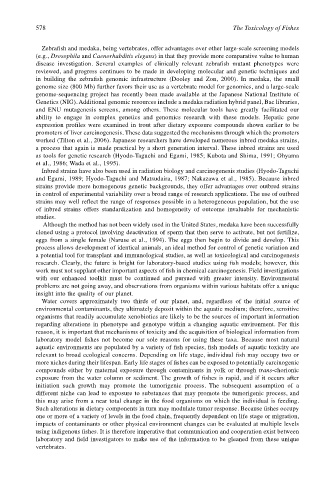Page 598 - The Toxicology of Fishes
P. 598
578 The Toxicology of Fishes
Zebrafish and medaka, being vertebrates, offer advantages over other large-scale screening models
(e.g., Drosophila and Caenorhabditis elegans) in that they provide more comparative value to human
disease investigation. Several examples of clinically relevant zebrafish mutant phenotypes were
reviewed, and progress continues to be made in developing molecular and genetic techniques and
in building the zebrafish genomic infrastructure (Dooley and Zon, 2000). In medaka, the small
genome size (800 Mb) further favors their use as a vertebrate model for genomics, and a large-scale
genome-sequencing project has recently been made available at the Japanese National Institute of
Genetics (NIG). Additional genomic resources include a medaka radiation hybrid panel, Bac libraries,
and ENU mutagenesis screens, among others. These molecular tools have greatly facilitated our
ability to engage in complex genetics and genomics research with these models. Hepatic gene
expression profiles were examined in trout after dietary exposure compounds shown earlier to be
promoters of liver carcinogenesis. These data suggested the mechanisms through which the promoters
worked (Tilton et al., 2006). Japanese researchers have developed numerous inbred medaka strains,
a process that again is made practical by a short generation interval. These inbred strains are used
as tools for genetic research (Hyodo-Taguchi and Egami, 1985; Kubota and Shima, 1991; Ohyama
et al., 1986; Wada et al., 1995).
Inbred strains have also been used in radiation biology and carcinogenesis studies (Hyodo-Taguchi
and Egami, 1989; Hyodo-Taguchi and Matsudaira, 1987; Nakazawa et al., 1985). Because inbred
strains provide more homogenous genetic backgrounds, they offer advantages over outbred strains
in control of experimental variability over a broad range of research applications. The use of outbred
strains may well reflect the range of responses possible in a heterogeneous population, but the use
of inbred strains offers standardization and homogeneity of outcome invaluable for mechanistic
studies.
Although the method has not been widely used in the United States, medaka have been successfully
cloned using a protocol involving deactivation of sperm that then serve to activate, but not fertilize,
eggs from a single female (Naruse et al., 1994). The eggs then begin to divide and develop. This
process allows development of identical animals, an ideal method for control of genetic variation and
a potential tool for transplant and immunological studies, as well as toxicological and carcinogenesis
research. Clearly, the future is bright for laboratory-based studies using fish models; however, this
work must not supplant other important aspects of fish in chemical carcinogenesis. Field investigations
with our enhanced toolkit must be continued and pursued with greater intensity. Environmental
problems are not going away, and observations from organisms within various habitats offer a unique
insight into the quality of our planet.
Water covers approximately two thirds of our planet, and, regardless of the initial source of
environmental contaminants, they ultimately deposit within the aquatic medium; therefore, sensitive
organisms that readily accumulate xenobiotics are likely to be the sources of important information
regarding alterations in phenotype and genotype within a changing aquatic environment. For this
reason, it is important that mechanisms of toxicity and the acquisition of biological information from
laboratory model fishes not become our sole reasons for using these taxa. Because most natural
aquatic environments are populated by a variety of fish species, fish models of aquatic toxicity are
relevant to broad ecological concerns. Depending on life stage, individual fish may occupy two or
more niches during their lifespan. Early life stages of fishes can be exposed to potentially carcinogenic
compounds either by maternal exposure through contaminants in yolk or through trans-chorionic
exposure from the water column or sediment. The growth of fishes is rapid, and if it occurs after
initiation such growth may promote the tumorigenic process. The subsequent assumption of a
different niche can lead to exposure to substances that may promote the tumorigenic process, and
this may arise from a near total change in the food organisms on which the individual is feeding.
Such alterations in dietary components in turn may modulate tumor response. Because fishes occupy
one or more of a variety of levels in the food chain, frequently dependent on life stage or migration,
impacts of contaminants or other physical environment changes can be evaluated at multiple levels
using indigenous fishes. It is therefore imperative that communication and cooperation exist between
laboratory and field investigators to make use of the information to be gleaned from these unique
vertebrates.

